Top News
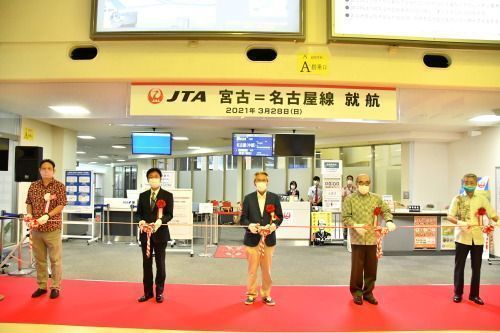
March 30, 2021 Ryukyu Shimpo
(Miyakojima) On March 28, Japan Transocean Air (JTA; president: Noriyuki Aoki) put into service a new route connecting Miyako and Nagoya (Chubu). Miyakojima mayor Kazuyuki Zakimi and members of tourism-related organizations gathered at a ceremony held at Miyako Airport on the occasion of the departure of the first flight on this route to see off the 107 passengers on the flight.
The airplanes used for the route will be Boeing 737-800, and one flight in each direction will run daily. JTA executive Hiroshi Itokazu addressed the ceremony-goers, saying, “This is our first new route in 10 years. We aim to continue making efforts to encourage tourism to Miyakojima going forward.”
In his address, Mayor Zakimi expressed his hopes, saying, “I am grateful for your support, as the wings of Okinawa, for our lives and tourism development. I hope that the launch of this new route will serve as an opportunity to become closer to Nagoya and lead to various types of exchange.”
(English translation by T&CT and Sandi Aritza)
Go to Japanese

March 30, 2020 Ryukyu Shimpo
Okinawa Prefecture announced a special emergency policy March 29 to help contain the spread of COVID-19, asking for strict observance of pandemic prevention measures for seasonal events starting in April such as the tomb-sweeping festival (shimi) and sports camps.
The prefecture has also asked the hosts of events such as new student and new employee ceremonies to look into ways to reduce the scope of the events, such as timed delays, spaced-out seating, or hosting the event online. They are encouraging events to require participants wear masks, be provided hand sanitizer, and for the venue to be well ventilated, and provide a way for those who are showing symptoms to participate online.
They area also demanding that companies and schools exercise self-restraint and refrain from common spring events such as parties for departing and new employees, welcome parties for new students, and other events that involve eating and drinking. They have also asked universities to warn their students about social gatherings.
They are also asking that tomb-sweeping festivals be limited to families that live together, and to keep attendance small and limit the time spent at the grave. Governor Denny Tamaki appealed to his constituents, “Getting a chance to meet relatives and close ones, light incense for your ancestors, and share a meal in front of their grave is an important annual event, but it is important to take measures to prevent the spread of disease, such as only participating with immediate family, and limiting the amount of people and length of time as much as possible.”
Also, with Olympians set to arrive on the island for training in preparation for the Olympics, as well other sports’ training camps where the athletes will be staying on the island, the prefecture is requiring a negative PCR and antigen test within 72 hours of arriving in the prefecture.
They are also requiring any event hosted in Okinawa to be limited to 5,000 attendees, and that the event follow all prefectural guidelines.
(English translation by T&CT and Sam Grieb)
Go to Japanese
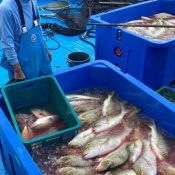
March 24, 2021 Ryukyu Shimpo
Yomitan – Around eight tons of spangled emperor fish called taman, which is now in season, was brought into Toya Fishing Port in Yomitan on March 23. Along with akajin grouper, akamachi snapper, and makubu blackspot tuskfish, taman is among the highest class of fish that can be caught in Okinawa. “We have rarely seen a haul this size in recent years,” said an excited representative from the Yomitan Fishery Cooperative (Hajime Kinjo, president). The fish can be bought directly from the Toya Fishing Port, or purchased at a supermarket in Okinawa.
From the end of March through April is the season for catching taman, as they make their seasonal migration to the waters near the coast of Okinawa to lay eggs. Normally, a single day’s catch during this peak season is around 400-500 kilograms, with this haul coming in around 20 times that.
The fish caught were measured at 40-70 cm. long, and weighing 2-4 kilograms each. Fishery Cooperative president Kinjo said, “This is a versatile fish, and delicious any way you cook it, whether it be sashimi, sauteed in soy sauce or grilled in butter. The best time to eat is around 2-3 days after it is caught, when the fish becomes softer,” calling on people to come try the delicious seasonal catch.
For inquiries, contact the Fishery Cooperative at 098 (956) 1640.
(English translation by T&CT and Sam Grieb)
Go to Japanese

Taman being inspected one-by-one by fishermen
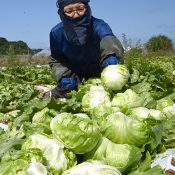
March 26, 2021 Ryukyu Shimpo
On March 25, due to being covered by a high-pressure system, sunny weather spread to regions throughout Okinawa. This heralds in the season for harvesting lettuce in Itoman City.
In Maehira, Itoman City, harvesting work is very busy in 45-year-old Naoyo Tamaki’s field, harvesting a lettuce crop that was started in mid-November last year. Under blue skies, lettuce plants are carefully harvested one-by-one. Although there was a lot of rain and harsh weather, Tamaki says the quality of the lettuce is adequate.
Due to the influence to the coronavirus crisis, demand for lettuce from hotels and the like has fallen, creating difficult circumstances. Tamaki, while looking at the fresh lettuce, said with a smile, “Although good to eat in a salad, a simple stir fry of tuna and soy sauce with lettuce is tasty and draws out the umami of the lettuce”. Harvesting will continue until mid-May.
(English translation by T&CT and Erin Jones)
Go to Japanese
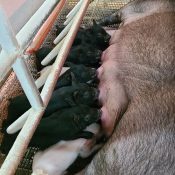
March 25, 2021 Ryukyu Shimpo
Hideki Tatemoto, a professor at the University of the Ryukyus Faculty of Agriculture, announced on March 24 that he developed a technology to supply frozen purebred-Agu pig sperm to industry. The Agu is an indigenous Okinawan pig breed restored to its pre-war state through backcrossing.
Pig sperm loses motility when frozen and thawed but through tireless research on preventing damage to the mitochondria—the energy source of sperm, Tatemoto succeeded in producing frozen sperm that does not lose its motility even after thawing. It is the first commercially viable frozen swine sperm in the world. Tatemoto plans to apply for a patent for the proprietary production technology.
Using frozen pig sperm enables breeding Agu pigs even in the summer months when sperm conditions deteriorate due to heat. It will allow stable production of Agu brand pigs throughout the year.
Ganaha Livestock (Nago City), Tatemoto’s research collaborator, developed a system to supply the frozen pig sperm to Agu pig producers. Agu-brand pork products manufactured from frozen sperm will be trademarked “University of the Ryukyus Agu-Ryuha” and will be marketed starting August.
The sperm count of purebred Agu pigs is lower than that of western swine breeds, and its motility is also lower in the summer, making breeding difficult. The frozen Agu sperm will be produced in the winter when they are in good condition and saved for the summer breeding months.
When the Camborough pig, a western breed, was artificially inseminated with frozen pig sperm during the hot July-September months, the conception rate was 80%, and the farrowing rate was 68%. Both results were higher than those of liquid semen.
Professor Tatemoto said, “This is the culmination of 15 years of basic research and repeated trial-and-error with Ganaha Livestock.”
(Englsih translation by T&CT and Monica Shingaki)
Go to Japanese

March 25, 2021 Ryukyu Shimpo
On March 24, 245 public elementary and junior high schools in Okinawa held closing ceremonies to mark the end of the school year. At Nakagusuku Minami Elementary School in Nakagusuku, measures to prevent the spread of Covid-19 meant that the entire school could not gather in one room for the ceremony, and so it was broadcast for pupils listening from their classrooms. Principal Moriichi Miyahira told the children, “The sixth graders are passing the baton to all of you. I hope that you will work to make our school wonderful. As all of you enter your next year of school, please stay healthy, stay safe, treasure your friends, and do your best to be kind.”
Juri Ikehara, homeroom teacher for first graders in section 1-5, handed out report cards to her pupils one by one. Ai Tome, a child in her class, said, “Arts and Crafts was fun. I want to make more friends in second grade.” Every elementary and junior high school in Okinawa will hold their closing ceremonies by March 25, and then spring break will begin.
(English translation by T&CT and Ellen Huntley)
Go to Japanese
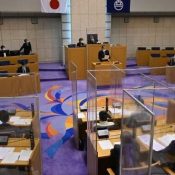
March 23, 2021 Ryukyu Shimpo
(Urasoe) On March 23, at its final regular meeting in March, the Urasoe City Council (Chairperson: Chobun Goeku) unanimously passed the “Ordinance for Achieving a Society that Honors Sexual Diversity” bill, which includes introduction of a “partnership system” by which the local government officially recognizes LGBT and other sexual minority couples. This ordinance, the first in Okinawa to focus specifically on sexual diversity, will take effect on October 1.
The bill prohibits discriminatory treatment and harassment for the reason of being a sexual minority, and also prohibits outing (publicly disclosing someone else’s sexual preference or sexual identity without the individual’s permission). It calls on business owners to make efforts to establish a workplace environment that takes sexual diversity into consideration.
The introduction of the partnership system is the second in Okinawa, following the one in Naha. The details of the system will be stipulated in regulations going forward.
On March 23, councilmembers Hayato Hamasaki and Yoshiji Mekaru left before deliberation of the bill. The bill passed unanimously without debate or questions.
(English translation by T&CT and Sandi Aritza)
Go to Japanese
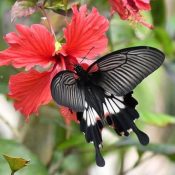
March 22, 2021 Ryukyu Shimpo
By Fumie Asato
Ogimi – A female great Mormon butterfly in its rare alcanor form (characterized by the tails on the end of the wings) was spotted fluttering around Ogimi March 6. Great Mormons are one of the largest butterflies in Japan after the paper kite butterfly, and the females are larger than the males. While these butterflies are characterized by the lack of a tail found on the hind wing of most other species of swallowtail butterflies, these tails can be found on some females, albeit rarely.
The photographer who found the butterfly is Noritaka Ichida, 74, a member of Yanbaru Forest Trust. Ichida said smiling, “I was surprised to find it. It is something that could only happen in the abundant nature of Ogimi, I am very happy.”
(English translation by T&CT and Sam Grieb)
Go to Japanese
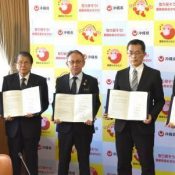
March 18, 2021 Ryukyu Shimpo
Representatives from five organizations including the Okinawa Prefectural government and the Okinawa Labor Bureau (OLB) signed a “comprehensive cooperation agreement” the morning of March 18, to resolve issues and promote effective policy for improving the health of working-age individual (age 20-64). The group has their eyes set on the goal of Okinawa recapturing the title of highest average life expectancy for both men and women by 2040, and will pour their efforts into working together to create health conditions for workers.
Health indicators for working-age people in Okinawa have experienced a continued downward trend. According to the OLB, the percentage of workers who exhibited abnormal indicators during a regular health examination reached 67.4% in 2019, the country’s worst for the 9th straight year. Indicators that point to lifestyle-related illness such as blood lipids, blood pressure, and liver function tests were particularly high.
The under-65 mortality rate in Okinawa is above the national average, with lifestyle-related causes of death such as heart disease, vascular brain disease, and diabetes again standing out.
In order to improve this situation, representatives of Okinawa Prefecture, the OLB, the Okinawa Medical Association (OMA), and the Japan Health Insurance Association’s (Kyokai Kenpo) Okinawa branch, and Japan Organization of Occupational Health and Safety (JOHAS) Okinawa Comprehensive Support Center met at the Okinawa Prefectural Office March 18, where they signed the cooperation agreement. The five representatives will devise a strategy for analyzing health examination data and investigate effective policies for promoting workers’ health.
Governor Denny Tamaki emphasized the significance of the five organizations working together, saying, “This will propel health improvements for working age people, and work towards realizing the extension of life expectancy and healthy life years, and to prevent early death.”
As for improving the health of workers in Okinawa, the OLB and Kyokai Kenpo have already put out health declarations, with the OLB’s “Hiyamikachi Health Management Declaration” and Kyokai Kenpo’s “Long Life and Happiness Uchina Health Declaration.” In April, at the start of the new fiscal year in Japan, these will be centralized into the “Uchina Health Management Declaration,” with the five representatives planning to enhance the content.
(English translation by T&CT and Sam Grieb)
Go to Japanese
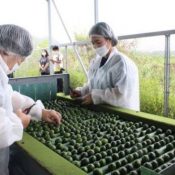
March 19, 2021 Ryukyu Shimpo
By Erina Ishii
In Hong Kong, demand for Okinawan shikuwasa (Okinawa lime) has exploded since the end of last year. 478COMPANY is a Tomigusuku-based company that supplies shikuwasa juice to Hong Kong. The company’s exports in 2020 grew twentyfold compared to the exports of 2019.
The recent focus on shikuwasa is attributed to a Japanese TV show that aired in Hong Kong in November 2020. The show introduced the benefits of nobiletin, a compound found in shikuwasa.
Arakaki Tsusho, a trading company based in Naha, saw sales of shikuwasa grow between ten- and twentyfold immediately after the program aired. Mika Arakaki, speaking as a representative of Arakaki Tsusho’s Hong Kong branch, explains, “Everyone considers Shikuwasa to be a superfood.”
Trends in Hong Kong change rapidly. Normally, a fad only lasts for around a month and a half. However, due to continuous promotion, sales trends continue to be good. In January, the company even secured a contract with the department store Sogo Hong Kong to make shikuwasa products part of their regular stock.
(English translation by T&CT and Ellen Huntley)
Go to Japanese

March 13, 2021 Ryukyu Shimpo
Under the management of General Manager Kaoru Honda, the resort hotel Hoshinoya Taketomi-jima in Taketomi-Cho, Taketomi Island, recently started supplying its drinking water by desalinating seawater. The hotel hopes to reduce plastic bottle waste, which has become a problem on the island due to drifting garbage and littering. With the introduction of the independent water supply, the hotel will no longer provide bottled mineral water in guest rooms. This will reduce about 50,000 plastic bottles per year.
In Taketomi Island, water for domestic use is supplied from Ishigaki Island, and water resources are limited. The seawater desalination system was introduced to avoid an increase in water directed to the hotel, given the move towards eliminating plastic bottles. The desalination system is the first of its kind for Hoshinoya group hotels nationwide.
The seawater desalination system, comprising a solar panel with a battery and a heat pump, is capable of desalting up to 60 tons of water per day. It can produce water, hot water, and electricity even in a natural disaster. On Feb 26, Hoshinoya Taketomi-jima became the first private facility to be designated an evacuation center in Taketomi.
The energy generated during the desalination process is utilized for water-temperature control and air conditioning, which may reduce carbon dioxide emissions by 35 tons per year.
Jun Adachi, who has been working on the desalination project, said, “We hope this will be a step toward energy self-sufficiency on this remote island. It will also provide a safe place for residents to evacuate to in an emergency. I hope we can give back to the community.”
(English translation by T&CT and Monica Shingaki)
Go to Japanese












 Webcam(Kokusai Street)
Webcam(Kokusai Street)


